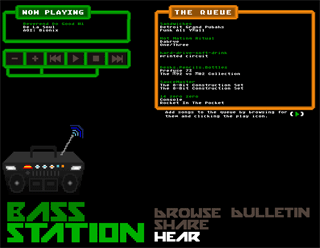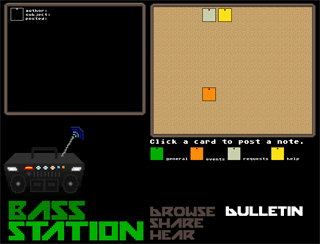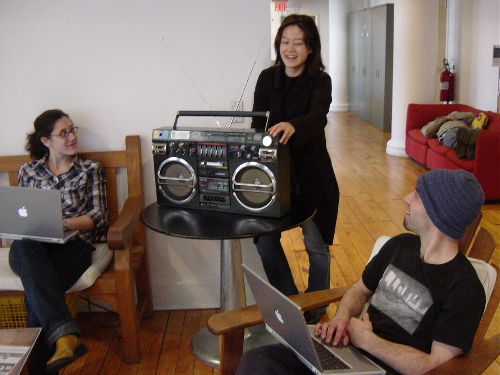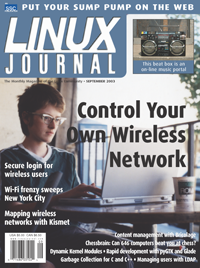
|
|
mark@argobot.com design portfolio Recent ProjectsThe SlidepipeBass-Station Tentagon |
 http://www.bass-station.net || info@bass-station.net |
||||||||
 The Bass-Station is a mobile, visually loud, and funky 1980s Boom Box. Imbedded within its shell is a modern computer and wireless networking components. By creating a locally accessible wireless network, people of an intimate community can use the Bass-Station as a hub through which they can freely and democratically exchange information. By actively observing the exchanges of a small community, you can learn things about that community that you couldn't by talking to any one of its members. The Bass-Station is also a shared stereo that makes its presence fun and entertaining.  Stills 
 

 Click a thumbnail for larger size. Papers
Press
 The familiar form of the Bass-Station, a large, classic, ghetto blaster, was chosen for its historical and symbolic implications. Since its introduction to mainstream culture, the Boom Box has become a symbol for spontaneous artistic collaboration. By bringing people of various skills and talents together, to share and explore each other's creativity, the ghetto blaster was a central element to the 1980's street culture. The Boom Box enabled people to meet spontaneously and independent of a fixed locale, to demonstrate new forms of dance they were inventing, expound new lyrics and rhythms to friends, hang out and be inspired by the activities going on, or simply to be a part of a localized community. Through these and other activities new relationships formed, shaping the unique and individual style of each community. Additionally, the mobility of the Boom Box allowed these communities to travel, bringing with them the ability to share their art with others, proliferating it across territories, and creating new styles and art forms. The Bass-Station is both a tribute and digital reconsideration of this tradition.   The Bass-Station grew out of our connection with street culture and music, combined with the unique context that we found ourselves in a close knit artistic community. The Interactive Telecommunications Program (ITP) is a tight community of tech savvy, artistic, and highly collaborative people. In this environment we constantly share and move various kind of digital media around. One of the things lacking at ITP was a central spot, with enough storage space, unmediated by the University, in which people can put various kinds of information. We also needed an easy way for us to exchange digital media. Anyone working in a group that uses digital media understands the hassles of moving around large pieces of content like animations, digital compositions, movie edits etc. With the increasing availability of wireless networking technology, especially in New York City, a large percentage of the ITP community already uses this medium for communication daily. An interesting thought for us, was to use this technology in a slightly different manner. We wanted to create a network that was specifically limited to local access yet could be used in a manner already familiar to everyone. The notion of an information space that had an overlap of physical and virtual communication, and served as a hub for the digital content of our community, brought the Bass-Station to life.  The Bass-Station broadcasts its wireless presence like a true access-point. When a person with a computer and network interface card is in the presence of the Bass-Station, they can select to associate and become a part of its network. Once associated, all interaction with the content and services is done via a web browser. By navigating to a website, any website for that matter, a person is automatically redirected to the site of theBass-Station. Currently, there are four things a person can do from the site: 


 **click to enlarge image The first is to browse what is present on the Bass-Station. As of now, the only digital media exposed to others are audio files. By browsing the songs that are present, a person can select something they would like to hear and add it to a communal playlist. There is a way to place other content but it is not visible from the site. Second, one is able to view the communal playlist and manipulate its controls. A funny, but interesting functionality, the ability to play, stop, fast-forward, or rewind through songs in the playlist is open for anyone associated with the Bass-Station to control. When someone fast-forwards through the song someone else queued up, they can easily get up and start searching around for who did it. Since the network is only available within the vicinity, the culprit must be close by. Another piece of functionality allows a person who wishes to share a piece of digital media to upload it to the Bass-Station. Lastly, there is a bulletin board present where people can leave messages for members of the community. There are various categories of messages: upcoming or ongoing events, help needed, requests for various things, and general comments. Through this bulletin board people can let others know of things they are doing, ask for assistance in learning something, probe the community for something pertinent to a project, or simply to gossip.  The external form of the Bass-Station is a vintage 1980's boom box. Internally, the tape and radio mechanisms have been removed and replaced with a modern miniature computer. The computer contains a sound output device, a large hard-drive, and a wireless network interface card. All the components that make up the device are standard and readily available around the world. Going one step deeper, the computer, running a modern operating system (Linux), uses the wireless interface card to create a self-standing yet open wireless network. It functions as an access-point broadcasting its presence in a limited range making the network only accessible by a localized community. The network that is created cannot access external networks nor is it accessible from other networks like the Internet, for example. A collection of networking services make it easy and simple for users in the presence of the network to join and begin interacting with the content that is there. A DHCP server [1] is used to automatically assign IP addresses to clients trying to join the network. A DNS server [2] is configured in a manner that will redirect users to a central location regardless of the domain that they are requesting (e.g. asking for www.google.com, or any other domain, will always direct a user to the Bass-Station's domain.) A web server is used to serve people the main interface to the Bass-Station's functionality. All of these services combined facilitate a person's interaction with the content and functionality of the Bass-Station. Lastly, there is a program called the Bassment Daemon that manages the audio engine and playing of music from the stereo's speakers. The Bass-Station is self-contained and mobile. All its components fit neatly into the shell of the stereo itself. Also, everything can be powered from a wall socket, or amazingly, it can be powered from 10 batteries that fit into the original casing of the stereo.
 The Bass-Station is alive, people think the project is fun and they enjoy using it. As a next step, we will be working on developing some software to further engage people in various ways. Specifically, we are looking into ways that will get people to use the Bass- Station as a place to network and connect with people in their environment, as well as become aware of the kinds of content available within the community.  On a larger scale, we are excited to look at what happens when several objects, like the Bass-Station, are dispersed over a slightly larger community, are tightly interlinked, and are still only locally accessible. The possible configurations of these objects, and the services they provide for a community, is not only an interesting piece in itself, but it provides a channel for other art works to travel through. |
||||||||

